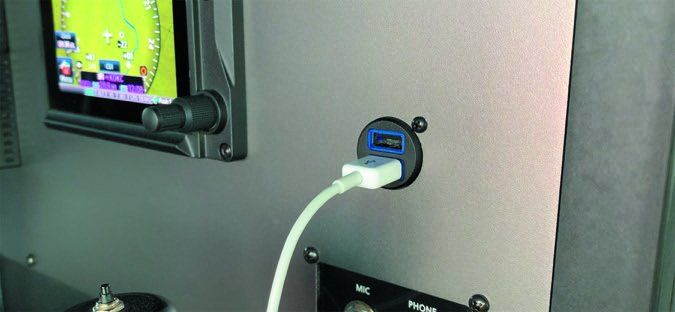When I started flying in 1994, there certainly wasn’t the need for accessory power in the cabin. These days it’s an entirely different story and the number of portable devices I carry grows by the month. Who thought you would have to charge your sunglasses? That’s why the market is being bombarded with panel USB charging ports. These are generally FAA-certified devices that mount either on the instrument panel or in interior components, and connect with the aircraft’s electrical bus for voltage.
But if you check the prices on these things you’ll be shocked to see them selling for hundreds of dollars, not counting installation. Are they really any better than hardware store USB ports that plug in to a cigarette lighter socket or even portable power banks that might sell for under $20?
In this article we’ll attempt to answer that and look at what’s available for installation.
Smoke Show, Anyone?
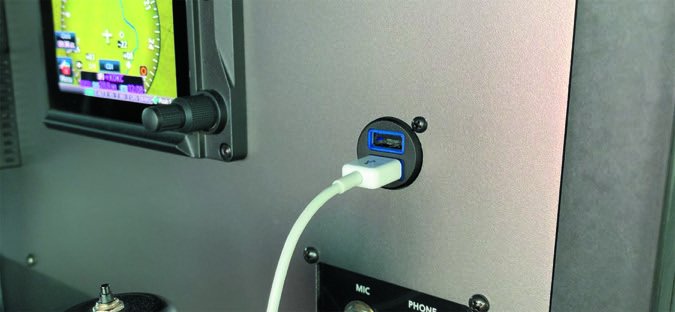
The price point for panel USB receptacles has become controversial, with buyers squawking about the several hundred bucks these things cost. The counterpoint is you might get acceptable performance from cheap models sourced from auto parts stores. But some users we spoke to said off-the-shelf plug-ins generate excessive audio system noise in their aircraft, so they really aren’t worth it. Let’s look at the tech, starting with input voltage considerations, and the caveats of playing with the wrong voltage.
For instance, many general aviation birds have 12-volt electrical systems. And there are a number of aircraft, like my Commander single, that have 28-volt electrics. Plug a 12-volt device into a 28-volt power source and it will smoke. And you’ll know when it’s smoking by the smell of acid under your nose. Yes, replacing a $1000 smoked iPad makes for a bad flying day.
Tech tip: Plug in the power adapter while the aircraft is on the ground-and without your smartphone or tablet attached. If it smokes, you’ll have destroyed a $5 adapter, not a $1000 tablet. Consider that USB cigarette chargers vary in terms of their supported voltage. Some-not all-of these devices are rated to handle 28 volts. In the Commander, the cigarette charging port puts out 28 volts, which is enough to smoke an inexpensive power adapter. I’ve seen one smoke, and was able to extinguish the burning circuit by quickly chopping the master switch.
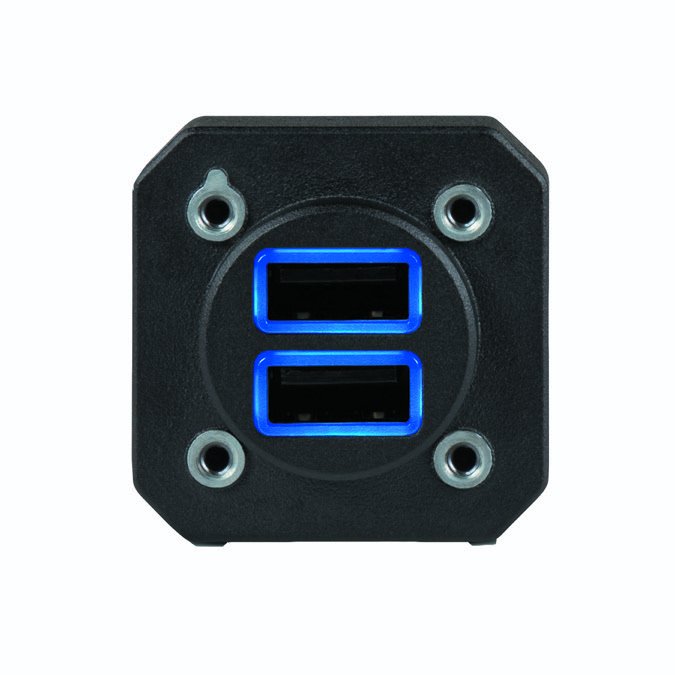
Still, there are a number of manufacturers who build power adapters rated between 12 and 32 volts DC, which are perfect for our 28-volt ships. Or, follow the lead of OEMs that are generous with cabin USB as standard (Cirrus, we think, nails the USB interface) and install a TSO’d USB port on the panel and connect it to the electrical bus.
We looked at these last in the March 2017 Aviation Consumer, including the True Blue Power TA102 and Guardian model. Since then, both lines have been expanded and both Garmin and Appareo sell panel power ports, too. More on those, after a quick lesson in the often misunderstood types of USB.
While often associated with USB 3.1 (and 3.2), USB-C is not the same thing. USB types, like A, B and C, denote the shape and form factor of the port and connector, rather than the data transfer speed. Many modern devices have moved away from the classic USB-A, USB-B and Micro-USB ports to USB-C, which is small, reversible and often goes hand-in-hand with faster transfer speeds.
You can identify the type of USB port or cable connector through the color of the plastic connector. USB 3.0 is blue, USB 2 is black, while USB-C is a small micro connector. The other big difference is that USB 3.1 draws 3 amps at 5 volts. USB-C has been used by manufacturers like Samsung for years, while Apple’s iPad Pro 11- and 12.9-inch models have USB-C ports. All USB-C cables must be able to carry a minimum of 3 amps (at 20 V, 60 W), but can also carry 5 amps (at 20 V, 100 W). USB-C to USB-C cables supporting 5 amps contain e-marker chips programmed to identify the cable and its current capabilities. These e-marker chips allow the charger and device to auto-negotiate a power setting. Who would have thought that cables would become “smart”?
Garmin Gsb 15
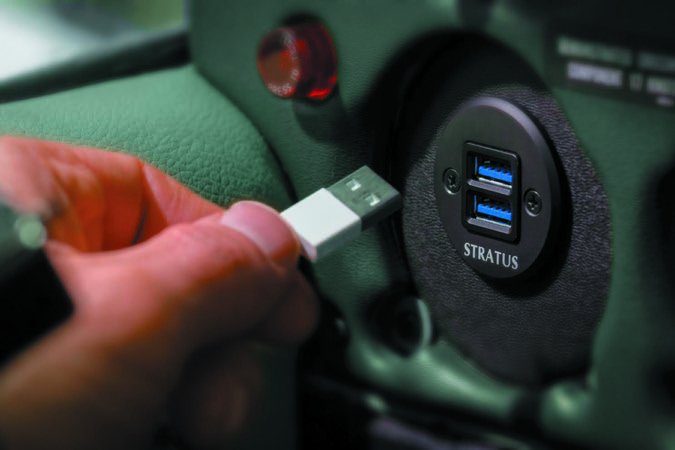
Garmin’s just-released GSB 15 is a TSO’d USB Type-A charging hub. With dual USB ports, it delivers 3 amps per USB port and measures just over 1.5 inches square and less than an inch deep. Garmin said it built it to be one of the smallest dual-port USB hubs designed for aviation.
It comes in two flavors-one for wiring into ship’s power from the back of the unit, and one that connects from the bottom of the case. Smart. Installers will need to use a 5-amp circuit breaker for protection, not included. Halo lighting around the exterior of the ports keeps you from searching for it during night ops.
Guardian Avionics
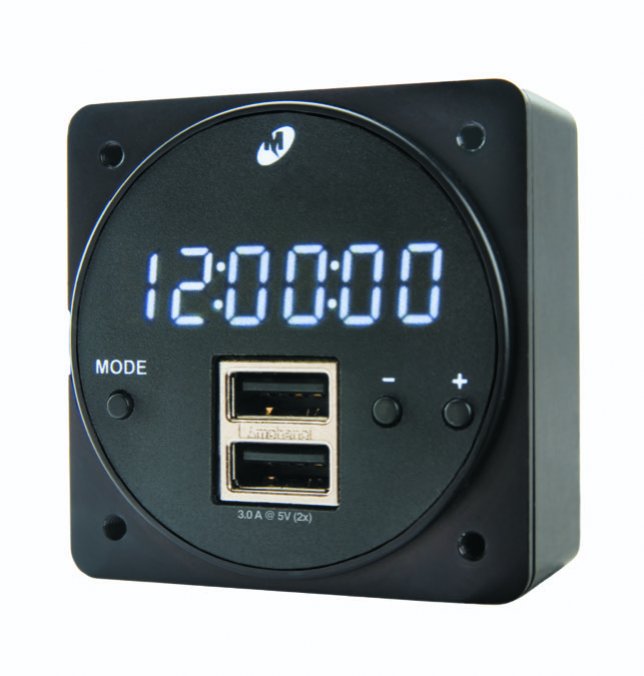
The company’s flagship power hub is the $299 smartPower IFDR 250-101. We like that the unit has front and rear connectors for tying in with Guardian’s smartPanel iPad/iPhone mounting system. It’s a clean install because the smartPanel mount’s lightning cable will connect to the rear of the IFRD-250-101, keeping the wires behind the panel.
The 250-101 series can be purchased in a variety of configurations, including one that fits a 0.9-inch cigarette lighter socket. There’s also a square version for more custom installs. For cigarette lighter conversions, remove the old socket and replace it with the 250-101 and connect it to a recommended 2-amp circuit breaker.
The model 250-201 uses a remote power supply-a small box for fitting behind the panel and connecting with the electrical bus and a 9-pin cable for routing into the cabin. It’s a good option for installing multiple power hubs in larger cabins. A variety of cables can be added to the 250-201, from lightning cables to USB Type B ports. The 250-101 port has green LED internal backlighting and includes a one-year limited warranty.
As for approval, all smartPower 150/250 USB power supplies from Guardian Avionics are approved for installation in certified aircraft and rotorcraft under 14 CFR Part 23, 27 and 29 as “Non-Required Safety Enhancing Equipment” (NORSEE) as outlined in FAA memorandum number PS-AIR-21.8-1602.
Guardian sells a 2.25-inch panel mount instrument adapter for $50. With it you can fit the port in a clock-size instrument cutout.
True Blue Power

True Blue is a division of Mid-Continent Instruments and Avionics, populating the OEM (from pistons to airliner cabins) and retrofit market with a variety of power supplies. True Blue Power has three USB charging products, with a new product to be launched in Q4 of 2019. If you’re sourcing a used power supply, know what you’re buying. The first product to market was the TA102, with USB Type A ports. The TA202 was released in 2016 and can be configured with USB Type B and/or USB-C ports. The MD93 is a digital clock with two USB Type A ports (the MD93H has high-output 3-amp ports).
It’s a confusing, but complete, product line. The main differentiators between the TA102, 202 and 302 are: the type of USB ports, maximum wattage output and amps per port. True Blue’s latest USB power product, the TA302, is expected to receive FAA TSO approval later this year.
The TA line allows for drop-in replacement when upgrading an existing power supply to an upgraded model. This is important in a world of changing charging tech. The task is to simply unscrew the unit from the panel, disconnect the wires and drop the new power supply in its place.
True Blue Power’s TA202 panel-mounted USB charger is available in a variety of configurations. Think of it like Lego-single-port USB-C or USB Type 3.1, dual USB-C, dual USB Type 3.1, or one USB-C port and one USB Type 3.1 port. There is also an option for bezel lighting.
As with the TA102 product, the TA202 is small. Mount it on an empty spot on the panel or in a clock-sized hole, using an optional mounting plate.
Finally, there are options for bottom- or rear-mounted cabling, offering a few more options when panel space is tight. The TA202 specs are 3.0 amps of current per port, with input voltage from 10 to 32 VDC. The output voltage is 5 VDC ( 0.25) per port, able to charge one or two devices simultaneously at full power. There’s also short-circuit, over-current and over-temperature protection-good features.
The TA302, expected by the end of 2019, has USB-C as standard and will be available in half-dozen configurations of USB Type A and USB-C with 3 amps of output per port. Unlike the TA102 and TA202, the TA302’s output voltage is variable, supporting 5, 9, 15, and 20 VDC. The TA302, when configured with Type A ports, is limited to 15 watts (5 VDC at 3 amps). Pricing will range from $412 to $751.
Appareo, Bendixking
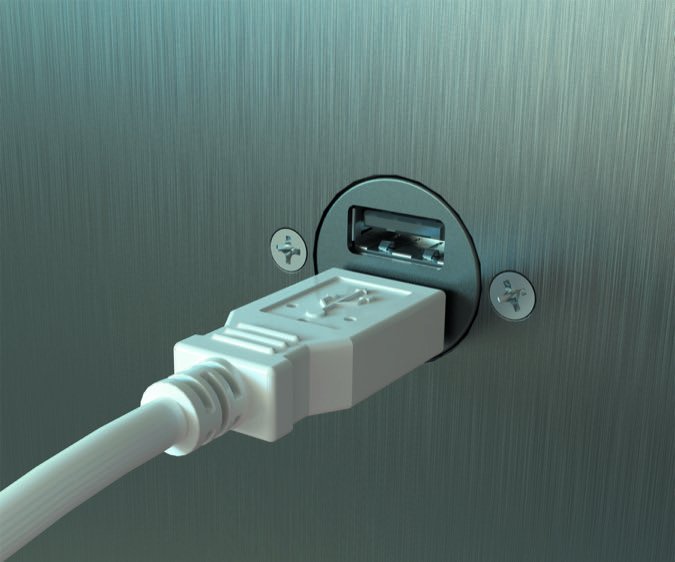
BendixKing recently released the $349 AeroPower panel/cabin USB charger, which is a rebranded Appareo Stratus Power device. This port has dual 2.5-amp USB Type A ports, has TSO certification and accepts 10-32 VDC input voltage.
For installation it requires a 2-amp circuit breaker for 28-volt aircraft and a 4-amp breaker for 14-volt aircraft. We say spring for a pullable breaker. The kit includes a faceplate, installation kit and a two-year warranty.
More Options
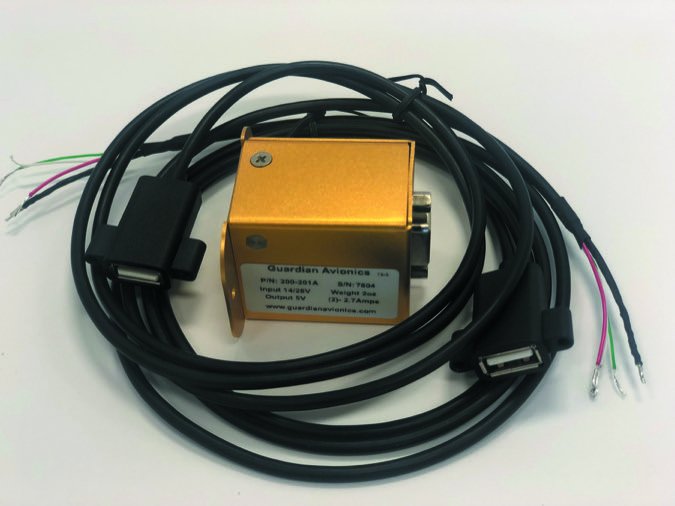
A number of avionics manufacturers are including USB ports on panel-mounted hardware. PS Engineering is one, with its $2495 PMA450B audio panel that has a USB-C charging port on the front bezel. The port provides 15 watts and 3.5 amps of power with a feature called Auto-Protection, preventing electrical shorts. The audio panel is slide-in compatible with Garmin’s GMA 340 audio panel for a plug and play installation process.
Garmin’s $1845 GMA 345 audio panel also has a charging port. It’s rated at 10 watts of power, 2.1-amp maximum charging current and has over-current protection.
For those on a budget, or who have a limited number of devices, a cigarette lighter adapter is a must-have. While there are a number of manufacturers who make USB adapters designed for use in aircraft, there are also hundreds of cigarette lighter power chargers available at local retailers and big box stores. But as mentioned earlier, they can be a source of unwanted noise and may not be compatible with 28-volt electrical systems.
Sporty’s and Aircraft Spruce, to name two respected vendors, sell a number of specialty products designed for aircraft use. Sporty’s (in addition to the Flight Gear battery mentioned in the sidebar on the opposite page) has the $39.99 Front and Backseat USB charger. The plug (which is inserted into the cigarette lighter) and hub (for back-seat passengers) each have one port that is enhanced with Adaptive Fast Charge technology. These two orange ports can simultaneously charge two compatible fast-charge devices, taking them from drained to 50 percent power in 30 minutes. Sporty’s has a new, smaller version of the Flight Gear Battery Pack. It’s 10,000 mAh (roughly half the capacity of the full-size one), has two 2-amp USB-A ports and one USB-C port. It’s small, about the size of a smartphone, and retails for $39.95.
We’ve used the Flight Gear dual USB charger, which shows bus voltage and the amount of amps the device being charged is drawing. The LED screen blinks and the device outputs an audible alarm if there’s low bus voltage. There’s also the $39.95 MyGoFlight DualMicro cigarette lighter USB charger. It works in 14- and 28-volt systems and has dual 2.4-amp output ports.
We’ve likely missed a handful of non-aviation portable chargers that will work in an aircraft. If there’s a portable charger that’s been working we’ll for you, we want to hear about it.
Last, ask your avionics shop which panel charger will work best in your aircraft, and consider installing one with other upgrades. Every shop we talked with said a big percentage of its installs also includes a USB power port, with the Appareo Stratus Power seemingly the most popular.

